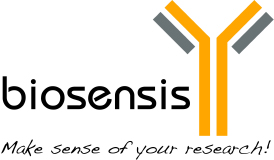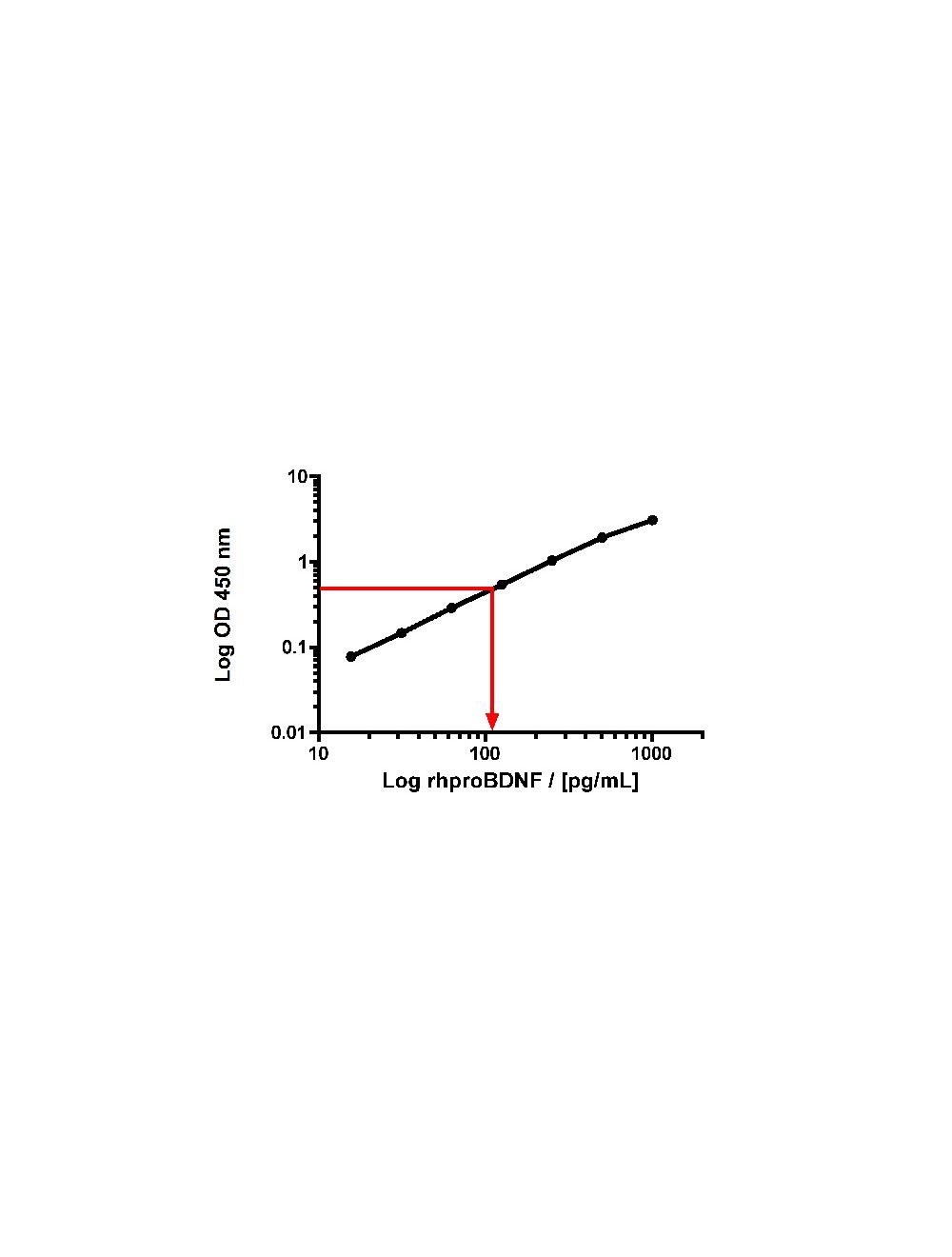Brain-derived neurotrophic factor, pro- (proBDNF), Human, Mouse, Rat, Rapid™ ELISA assay
- Product Name Brain-derived neurotrophic factor, pro- (proBDNF), Human, Mouse, Rat, Rapid™ ELISA assay
-
Product Description
The Biosensis proBDNF RapidTM enzyme-linked immunosorbent assay (ELISA) Kit is a sandwich ELISA that allows the specific, fast and reliable quantification of proBDNF in less than 4 hours in cell culture supernatants, human serum and EDTA-plasma only if used as directed. Please refer to the kit protocol for specific use instructions for each substrate application, in particular human blood samples.
This ELISA kit consists of a pre-coated monoclonal anti-proBDNF capture antibody, a biotinylated anti-matureBDNF detection antibody and horseradish peroxidase (HRP)-conjugated streptavidin. The addition of a substrate (3,3',5,5'-tetramethylbenzidine, TMB) yields a colored reaction product which is directly proportional to the concentration of proBDNF present in samples and protein standards. A proBDNF positive control (QC sample) is provided to assure consistent assay performance.
This proBDNF ELISA kit employs a recombinant, cleavage-resistant human proBDNF standard produced in mammalian cells by Biosensis and validated against externally available proBDNF proteins.
Note that accurate proBDNF quantification in human serum and EDTA-plasma requires the addition of Heterophilic Antibody Blocker BL-004-500 provided in the kit, and available for purchase separately.
This ELISA kit has not been tested for other applications. It has been configured for research use only and is not to be used for diagnostic or clinical procedures. - Alternative Names Brain-derived neurotrophic factor; BDNF; Abrineurin
- Application(s) ELISA
-
Specificity
Human proBDNF. The capture antibody used in this ELISA kit binds to an epitope within the pro-domain of proBDNF. Thus, this ELISA detects the full length form of proBDNF and does not quantify mature BDNF. Whether this ELISA kit can detect truncated BDNF is unknown at present. Mature BDNF cross-reactivity was assessed by spiking 28 kDa mature BDNF protein obtained from WHO (www.nibsc.org) into a 1/5 diluted human serum sample at 5 ng/mL, which represents a BDNF concentration level of 25 ng/mL in undiluted, normal human serum. Cross-reactivity of mature BDNF was < 0.3% (w/v), or < 0.1% in molar concentration.
The assay antibodies do not cross-react with nerve growth factor (NGF), neurotrophin-3 (NT-3) or NT-4/5. - Species Reactivity Human, Mouse, Rat
- Immunogen Description Human recombinant proBDNF, mutated to be cleavage-resistant, made in 293F cells
- Range 15.6 - 1,000 pg/mL
- Sensitivity Typical limit of detection (LOD) for proBDNF is 6 pg/mL determined as 150% of the blank value.
- Regulatory Status For research use only.
Product Info
-
Product Description
The Biosensis proBDNF RapidTM enzyme-linked immunosorbent assay (ELISA) Kit is a sandwich ELISA that allows the specific, fast and reliable quantification of proBDNF in less than 4 hours in cell culture supernatants, human serum and EDTA-plasma only if used as directed. Please refer to the kit protocol for specific use instructions for each substrate application, in particular human blood samples.
This ELISA kit consists of a pre-coated monoclonal anti-proBDNF capture antibody, a biotinylated anti-matureBDNF detection antibody and horseradish peroxidase (HRP)-conjugated streptavidin. The addition of a substrate (3,3',5,5'-tetramethylbenzidine, TMB) yields a colored reaction product which is directly proportional to the concentration of proBDNF present in samples and protein standards. A proBDNF positive control (QC sample) is provided to assure consistent assay performance.
This proBDNF ELISA kit employs a recombinant, cleavage-resistant human proBDNF standard produced in mammalian cells by Biosensis and validated against externally available proBDNF proteins.
Note that accurate proBDNF quantification in human serum and EDTA-plasma requires the addition of Heterophilic Antibody Blocker BL-004-500 provided in the kit, and available for purchase separately.
This ELISA kit has not been tested for other applications. It has been configured for research use only and is not to be used for diagnostic or clinical procedures. -
Related Products
Brain-derived neurotrophic factor, mature (BDNF, mature), Human, Mouse, Rat, Rapid™ ELISA assay
Mature BDNF/proBDNF Combo (BEK-2211/2237), Human, Mouse, Rat, Rapid™ ELISA assay
Heterophilic antibody blocker for BEK-2217, BEK-2221, BEK-2237 & BEK-2240 and similar ELISA assays
- Application(s) ELISA
- Application Details ELISA. For the quantification of Brain-derived neurotrophic factor, pro- (proBDNF) in Culture Supernatant, Serum, Plasma (Citrate), Plasma (EDTA), Cell Lysates, Tissue Homogenates. Please download the detailed product insert for complete instructions for the successful use of this ELISA. Use only as directed.
- Target Brain-derived neurotrophic factor, pro- (proBDNF)
-
Specificity
Human proBDNF. The capture antibody used in this ELISA kit binds to an epitope within the pro-domain of proBDNF. Thus, this ELISA detects the full length form of proBDNF and does not quantify mature BDNF. Whether this ELISA kit can detect truncated BDNF is unknown at present. Mature BDNF cross-reactivity was assessed by spiking 28 kDa mature BDNF protein obtained from WHO (www.nibsc.org) into a 1/5 diluted human serum sample at 5 ng/mL, which represents a BDNF concentration level of 25 ng/mL in undiluted, normal human serum. Cross-reactivity of mature BDNF was < 0.3% (w/v), or < 0.1% in molar concentration.
The assay antibodies do not cross-react with nerve growth factor (NGF), neurotrophin-3 (NT-3) or NT-4/5. -
Target Cross-Reactivity (ELISA)
Mature BDNF cross-reactivity was assessed by spiking 28 kDa mature BDNF protein obtained from WHO (www.nibsc.org) into a 1/5 diluted human serum sample at 5 ng/mL, which represents a BDNF concentration level of 25 ng/mL in undiluted, normal human serum. Cross-reactivity of mature BDNF was < 0.3% (w/v), or < 0.1% in molar concentration.
The assay antibodies do not cross-react with nerve growth factor (NGF), neurotrophin-3 (NT-3) or NT-4/5. - Target Host Species Human
- Species Reactivity Human, Mouse, Rat
- Immunogen Description Human recombinant proBDNF, mutated to be cleavage-resistant, made in 293F cells
- Range 15.6 - 1,000 pg/mL
- Sensitivity Typical limit of detection (LOD) for proBDNF is 6 pg/mL determined as 150% of the blank value.
- Sample Type Cell Lysates, Culture Supernatant, Plasma (Citrate), Plasma (EDTA), Serum, Tissue Homogenates
- Detection Method Colorimetric
- Kit Components The ELISA kit box contains 96-well pre-coated strip plate(s), protein standards, QC sample, detection reagents, heterophilic antibody blocker, wash and sample buffers, substrate buffer and detailed protocols.
- Storage Instructions Store at 2-8°C
- Storage Temperature 2-8°C
- Batch Number Please see item label.
- Expiration Date 12 months from purchase.
- Alternative Names Brain-derived neurotrophic factor; BDNF; Abrineurin
- Uniprot Number P23560
- Uniprot Number/Name P23560 (BDNF_HUMAN)
- Scientific Background BDNF belongs to the neurotrophin family and regulates the survival and differentiation of neurons during development. The alterations in BDNF expression induced by various kinds of brain insult including stress, ischemia, seizure activity and hypoglycemia, may contribute to some pathologies such as depression, epilepsy, Alzheimer's, and Parkinson's disease. FUNCTION: Promotes the survival of neuronal populations that are all located either in the central nervous system or directly connected to it. Major regulator of synaptic transmission and plasticity at adult synapses in many regions of the CNS. The versatility of BDNF is emphasized by its contribution to a range of adaptive neuronal responses including long-term potentiation (LTP), long-term depression (LTD), certain forms of short-term synaptic plasticity, as well as homeostatic regulation of intrinsic neuronal excitability. SUBUNIT: Monomers and homodimers. Binds to NTRK2/TRKB. SUBCELLULAR LOCATION: Secreted protein. Post Translation Modification (PTM): The propeptide is N-glycosylated and glycosulfated. PTM: Converted into mature BDNF by plasmin (PLG) (By similarity). DISEASE: Defects in BDNF are a cause of congenital central hypoventilation syndrome (CCHS); also known as congenital failure of autonomic control or Ondine curse. CCHS is a rare disorder characterized by abnormal control of respiration in the absence of neuromuscular or lung disease, or an identifiable brain stem lesion. A deficiency in autonomic control of respiration results in inadequate or negligible ventilatory and arousal responses to hypercapnia and hypoxemia. CCHS is frequently complicated with neurocristopathies such as Hirschsprung disease that occurs in about 16% of CCHS cases. SIMILARITY: Belongs to the NGF-beta family.
- Shipping Statement For order quantities larger than 1 plate, this product is supplied in package units of 2 plates.
- Shipping Temperature 2-8°C (on cold packs)
- UNSPSC CODE 41116158
- Regulatory Status For research use only.
Specifications
-
Specific References
Hardiany NS et al. (2024) Exploration of neuroprotective effect from Coriandrum sativum L. ethanolic seeds extracts on brain of obese rats Sci Rep.14(1):603. Application: Rat, Brain homogenate
Li Z et al. (2023) Blue light at night produces stress-evoked heightened aggression by enhancing brain-derived neurotrophic factor in the basolateral amygdala Neurobiol Stress. 28:100600. Application: Rat, Tissue homogenate
Huang Y et al. (2023) Protocol for a single-blind randomized clinical trial to test the efficacy of bilateral transcranial magnetic stimulation on upper extremity motor function in patients recovering from stroke Trials. 24(1):601 Application: Human, Serum
Delgado-Peraza F et al. (2023) Neuron‑derived extracellular vesicles in blood reveal efects of exercise in Alzheimer’s disease Alzheimers Res Ther. 15(1):156. Application: Human, Neuron-derived extracellular vesicle lysates (isolated from plasma-EDTA)
Granitzer S et al. (2023) BDNF and KISS-1 Levels in Maternal Serum, Umbilical Cord, and Placenta: The Potential Role of Maternal Levels as Effect Biomarker Expos. Health. [Epub ahead of print]. Application: Human, Serum; Cell culture supernatant.
Covarrubias C et al. (2023) Decrease in the Ratio proBDNF/BDNF in the Urine of Aging Female Patients with OAB Metabolites. 13(6), 723. Application: Human, Urine.
Higuchi Y et al. (2023) Serotonergic circuit dysregulation underlying autism-related phenotypes in BTBR mouse model of autism Neuropharmacology. 237:109634. Application: Mouse, Brain tissue homogenate.
Eitan E et al. (2023) Synaptic proteins in neuron-derived extracellular vesicles as biomarkers for Alzheimer’s disease: novel methodology and clinical proof of concept Extracell Vesicles Circ Nucleic Acids. 4:133-50. Application: Human, neuron-derived extracellular vesicles lysates.
Tsotsoros CE et al. (2022) Pilot Associations between Adverse Childhood Experiences, Executive Function, and Brain-Derived Neurotrophic Factor (BDNF) among Adults with Excess Adiposity Obesities. 2, 276-284. Application: Human, serum.
Freidle M et al. (2022) Behavioural and neuroplastic effects of a double-blind randomised controlled balance exercise trial in people with Parkinson's disease. NPJ Parkinsons Dis. 8(1):12. Application: Human, serum.
March B et al. (2021) ELISA-based quantification of neurotrophic growth factors in urine from prostate cancer patients. FASEB Bioadv. [Epub ahead of print]. Application: Human, urine.
Yi X et al. (2021) Serum mBDNF and ProBDNF Expression Levels as Diagnosis Clue for Early Stage Parkinson's Disease. Front Neurol. 12:680765. Application: Human, serum.
Nomura S et al. (2021) Effects of a Tea Cultivar "MK5601" on Behaviors and Hippocampal Neurotrophin-3 Levels in Middle-Aged Mice. J Nutr Sci Vitaminol (Tokyo). 67(3):170-179. Application: Mouse, hippocampal RIPA homogenates.
Li P et al. (2021) Intermediation of perceived stress between early trauma and plasma M/P ratio levels in obsessive-compulsive disorder patients. J Affect Disord. 285:105-111 Application: Human, plasma.
Lai NS et al. (2021) Increased Serum Levels of Brain-Derived Neurotrophic Factor Contribute to Inflammatory Responses in Patients with Rheumatoid Arthritis. Int. J. Mol. Sci. 22(4):1841 Application: Human, serum and culture supernatants.
Fukumoto M et al. (2019) Induction of brain-derived neurotrophic factor in enteric glial cells stimulated by interleukin-1β via a c-Jun N-terminal kinase pathway. J. Clin. Biochem. Nutr. [Epub ahead of print]. Application: Human, culture supernatant.

 1800 605-5127
1800 605-5127 +61 (0)8 8352 7711
+61 (0)8 8352 7711


